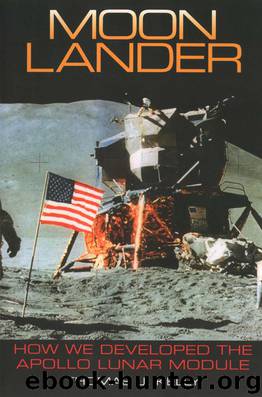Moon Lander: How We Developed the Apollo Lunar Module (Smithsonian History of Aviation and Spaceflight) by Kelly Thomas J

Author:Kelly, Thomas J. [Kelly, Thomas J.]
Language: eng
Format: epub
ISBN: 9781588343611
Publisher: Smithsonian
Published: 2012-01-10T23:00:00+00:00
Stress Corrosion
The Super Weight Improvement Program resulted in the widespread use of chemical milling for structural parts on LM that rendered aluminum alloy parts more susceptible to stress corrosion, because it left a relatively rough and open-pored surface finish. Even without chem milling, certain aluminum alloys were vulnerable to this phenomenon, which in the 1960s was just being encountered and understood. Stress corrosion is intergranular corrosion occurring at the metal grain boundaries, usually visible only through a microscope looking at an etched and polished surface. A combination of steady stress and moisture or humidity is required to produce this corrosion. The stress levels can be relatively low—well below the recommended working stress of the material. Cracks and failures from stress corrosion typically do not develop until months or years after the original stress is applied—and this became a hidden time bomb for the LM structure, surfacing widely in the schedule-critical years of 1967 and 1968 and finding its way to the show stoppers list.
The most common applied stress causing this problem was “fit-up” stress, which resulted when parts did not fit or nest together exactly. When the fasteners were tightened, the parts were deflected until they made complete contact and the stress resulting from the deflection was locked into the material. Some joints, particularly the rod ends inserted into LM structural tubes, required a press fit to provide a solid, immovable connection. In such cases a predetermined stress level was purposely locked in upon assembly.
Minimizing fit-up stress required parts that fit together well or were carefully shimmed upon assembly to eliminate deflections when the fasteners were tightened. Training of assembly mechanics was revised to emphasize the importance of proper parts fit up and techniques for accomplishing it. We also reviewed the engineering tolerances on parts assemblies, particularly press fit joints.
Some stress corrosion of thin tabs was noted on LTA-1 as early as 1964, and a stress corrosion inspection and survey was performed on all LMs then under construction. The problem continued at a low level, with an occasional crack found, until a rash of cracked parts was discovered in mid-1967, beginning with LM-1. The cracks were mostly in the press fit ends of structural tubes, although some thin tabs were found cracked also. Mueller was furious. At that late date the Apollo schedule was threatened by this insidious problem—it could exist on almost any part, anywhere within the LM. The day after an inspection, a new crack could develop, because the nature of the phenomenon was chronic and progressive. LM stress corrosion was branded a show stopper.
Heavily pressured from above, I went to general quarters. Led by Bob Carbee, our best structural design and materials troubleshooters, Len Paulsrud, Will Bischoff, and Frank Drum assembled a team from Engineering, Manufacturing, and Quality Control to inspect all the accessible structure on the LMs under construction. Visual inspection was conducted with flashlights and magnifying glasses. Suspect areas were brushed with Zy-glo dye penetrant, which glowed under ultraviolet light and enhanced the visibility of tiny cracks.
Download
This site does not store any files on its server. We only index and link to content provided by other sites. Please contact the content providers to delete copyright contents if any and email us, we'll remove relevant links or contents immediately.
| American National Standards Institute (ANSI) Publications | Architecture |
| History | Measurements |
| Patents & Inventions | Research |
Whiskies Galore by Ian Buxton(41941)
Introduction to Aircraft Design (Cambridge Aerospace Series) by John P. Fielding(33095)
Small Unmanned Fixed-wing Aircraft Design by Andrew J. Keane Andras Sobester James P. Scanlan & András Sóbester & James P. Scanlan(32767)
Craft Beer for the Homebrewer by Michael Agnew(18200)
Turbulence by E. J. Noyes(7983)
The Complete Stick Figure Physics Tutorials by Allen Sarah(7339)
Kaplan MCAT General Chemistry Review by Kaplan(6903)
The Thirst by Nesbo Jo(6882)
Bad Blood by John Carreyrou(6584)
Modelling of Convective Heat and Mass Transfer in Rotating Flows by Igor V. Shevchuk(6408)
Learning SQL by Alan Beaulieu(6239)
Weapons of Math Destruction by Cathy O'Neil(6220)
Man-made Catastrophes and Risk Information Concealment by Dmitry Chernov & Didier Sornette(5958)
Digital Minimalism by Cal Newport;(5707)
Life 3.0: Being Human in the Age of Artificial Intelligence by Tegmark Max(5519)
iGen by Jean M. Twenge(5387)
Secrets of Antigravity Propulsion: Tesla, UFOs, and Classified Aerospace Technology by Ph.D. Paul A. Laviolette(5336)
Design of Trajectory Optimization Approach for Space Maneuver Vehicle Skip Entry Problems by Runqi Chai & Al Savvaris & Antonios Tsourdos & Senchun Chai(5040)
Pale Blue Dot by Carl Sagan(4960)
